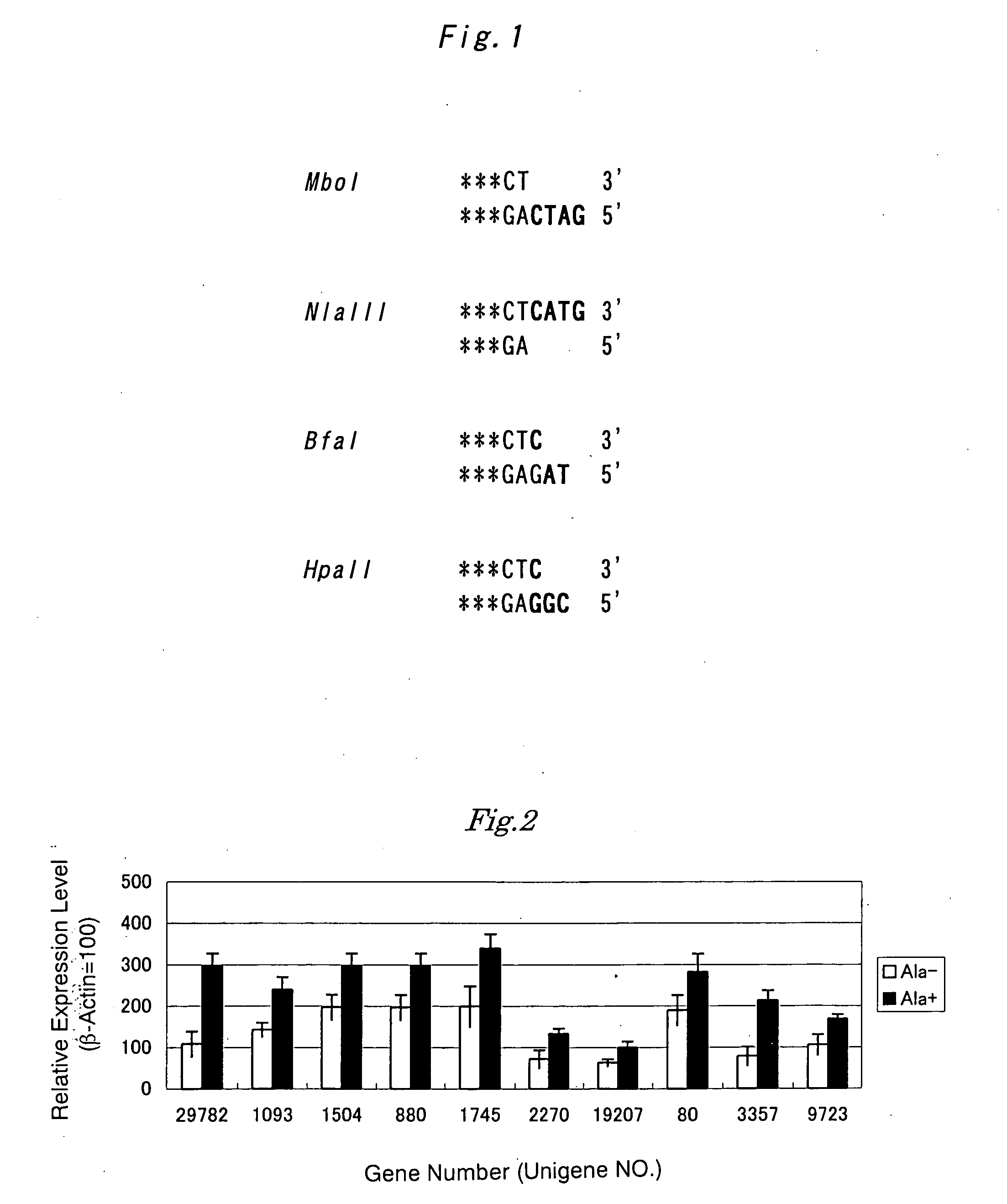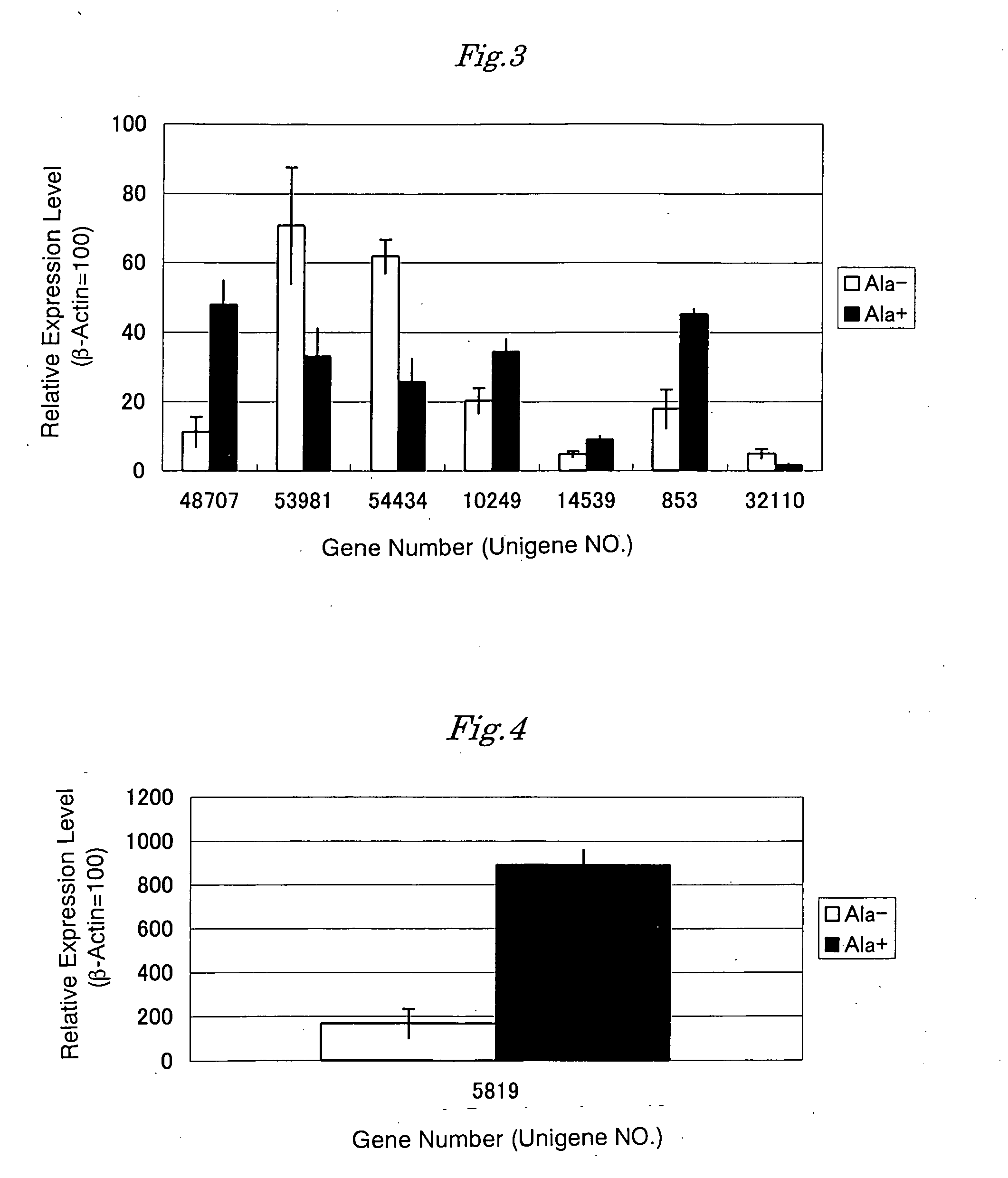Gene panel participating in liver regeneration
- Summary
- Abstract
- Description
- Claims
- Application Information
AI Technical Summary
Benefits of technology
Problems solved by technology
Method used
Image
Examples
example 1
Preparation of Regenerating Liver
[0057] Ten week-old F344 / DvCrj (Fischer) rats were etherized. The abdomen was incised, and the left lobe and the intermediate lobe of the liver were extruded from the incision. The liver was bound with sutures between the left lobe and the intermediate lobe and between the right lobe and the caudate lobe. The right lobe and the caudate lobe were left in the body, and the left lobe and the intermediate lobe were resected. Then, the incision was closed with a suture. As for the animals which were examined at 0 hour after the excision, suturing was not performed, and the remaining liver was successively extracted. The incision was opened again at 1, 6, 12, 24 and 168 hours after the hepatectomy to extract the remaining liver (regenerating liver). The weight of the remaining livers (right lobe and caudate lobe) was about 30% of the weight of the whole rat liver (right lobe, left lobe, intermediate lobe and caudate lobe).
[0058] Three liver regeneration...
example 2
Expression Analysis of Genes Involved in L-alanine Metabolism During Liver Regeneration by Tagman PCR (SYBR Green)
[0095] In the same manner as in the above and , total RNA was purified from the remaining livers (regenerating livers) at 0, 1, 6, 24, 48 and 168 hours after the partial hepatectomy of rats, and changes in expression levels of various genes were examined by using the Taqman PCR (SYBR Green) method.
(1) Preparation of Template
[0096] The synthesis of template cDNA used for Taqman PCR (SYBR Green) was performed by using SuperScript First-Strand Synthesis System for RT-PCR (GIBCO BRL). In an amount of 500 ng of total RNA, 1 μl of 0.5 μg / μl Oligo (dT)12-18 and 1 μl of 10 mM dNTP mix were dissolved in DEPC-treated water to obtain a total volume of 10 μl. A reaction was allowed at 65° C. for 5 minutes, and the reaction mixture was cooled on ice, added and mixed with 2 μl of 10×RT buffer, 4 μl of 25 mM MgCl2, 2 μl of 0.1 M DTT and 1 μl of RNase Inhibitor, and kept warm at 42...
example 3
Expression Analysis of Genes Involved in L-Alanine Metabolism by Tagman PCR (SYBR Green) with L-Alanine Administration During Liver Regeneration
[0102] Expression changes were examined with L-alanine administration during liver regeneration regarding 59 types of rat genes involved in L-alanine metabolism extracted in Example 2.
(1) Preparation of Regenerating Liver
[0103] Five 6 week-old F344 male rats (120 g) were fed for 6 days by giving feed CRF-1 (Oriental Yeast) and water and then divided into 2 groups (Group 1 and Group 2) each consisting of rats with the same body weight. At 24 hours before dissection, 70% partial hepatectomy (left lobe and intermediate lobe) was performed by the method of Higgins-Anderson (Higgins, G M and Anderson, R M, Arch. Pathol. 12, 186-191, 1931). On the day of autopsy, the rats were starved for 6 hours before the dissection. At 18 and 21 hours after the partial hepatectomy, 2 g / 10 ml / kg BW of L-alanine was orally administered as an aqueous solution ...
PUM
| Property | Measurement | Unit |
|---|---|---|
| Fraction | aaaaa | aaaaa |
| Fraction | aaaaa | aaaaa |
| Fraction | aaaaa | aaaaa |
Abstract
Description
Claims
Application Information
 Login to View More
Login to View More - R&D
- Intellectual Property
- Life Sciences
- Materials
- Tech Scout
- Unparalleled Data Quality
- Higher Quality Content
- 60% Fewer Hallucinations
Browse by: Latest US Patents, China's latest patents, Technical Efficacy Thesaurus, Application Domain, Technology Topic, Popular Technical Reports.
© 2025 PatSnap. All rights reserved.Legal|Privacy policy|Modern Slavery Act Transparency Statement|Sitemap|About US| Contact US: help@patsnap.com


